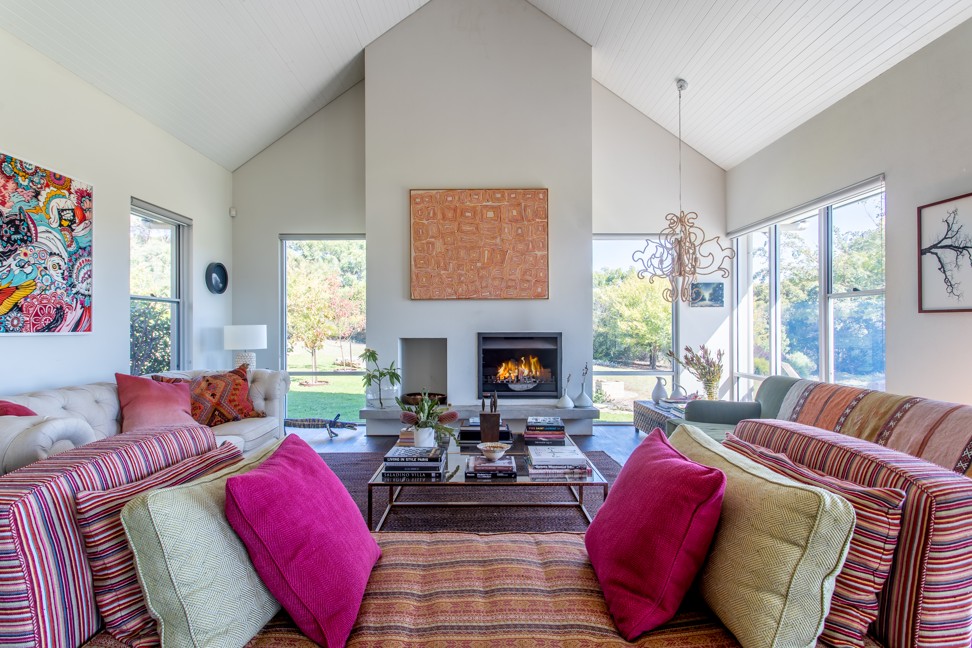
Inside a couple’s Margaret River retreat in Western Australia: a ‘timeless home in traditional forms’
The eight-bedroom holiday house continues to evolve and surprise as it matures into a home
Alouarn House may have been completed 13 years ago, but for owners Michelle and James Paterson, it remains a work in progress.
Built on vacant land bordering a national park, in Western Australia’s Margaret River region, the sprawling 6,458 sq ft, eight-bedroom house, on a 1.2-hectare plot, was designed as a holiday home for family and friends.
“When we lived in Hong Kong, we’d come down with lots of people, and every second year we’d have a massive New Year’s Eve cricket game,” says South African-born Michelle, describing the event held on their extensive lawns, complete with a pavilion and Mongolian tents.
As evocative as the crack of a bat on a summer’s day is the picture Michelle paints of how their architect, Theo Mathews, arrived at the design, which he characterises as a “timeless home in traditional forms”.
We wanted a house with a lot of windows, that was big and could accommodate a lot of people, but that didn’t look grand
Says Michelle: “We wanted a house with a lot of windows, that was big and could accommodate a lot of people, but that didn’t look grand. We wanted the house to be authentically Australian, but with things from Europe that work – natural stone, natural wood. We didn’t want a suburban-looking house, where you walk out and the swimming pool is right there. We wanted it far away from the house – sort of like those old houses in England, where you take your towel and book and go to the swimming pool.” Back in Hong Kong recently for an art fair, Michelle is nostalgic about her family’s two stints in the city, from 2000 to 2002 and 2005 to 2009.
“We thought we’d live here forever,” she says, remembering the MacDonnell Road home of her family of five and their rustic weekender in Pak Sha O. However, when her Australian husband, a former head of equity research at CLSA, was transferred again, this time to Sydney, she seized the opportunity and realised a dream.
Three years after the 2010 move, Michelle opened an art gallery, .M Contemporary, in one of the city’s swankiest suburbs.
Like their lives, their holiday house (built when the family lived in Seoul, South Korea) continues to change: new furniture keepsakes are replacing old placeholders; art is being added and moved around; and several rooms have been reworked, because the children have grown up and the house has become a holiday rental.
Michelle’s favourite indoor area is the previously shunned living room at the far end of one of two long “sheds” that make up the house: one is the “sleeping side”; the other, separated by a passageway and featuring high ceilings and an abundance of light, accommodates a kitchen, family and dining rooms, plus that formerly unwelcoming space. Here, colour (in artwork, cushions, upholstery) and an irresistible daybed (with a 60kg down mattress) draw people in.
“Now if I’m looking for anyone, they’ll be there reading or watching something on their iPad,” Michelle says. “It’s become the most popular room.”
It was important for us to have a house that would allow us to live outdoors in winter and in summer
Also evident is that the preferred way of entering the house is via the back door, which leads from a covered outdoor area, with a barbecue and fireplace, into the kitchen.
“It was important for us to have a house that would allow us to live outdoors in winter and in summer,” she says.
Rarely using the formal entrance meant the original solid door could be redesigned to incorporate glass panels allowing more light into the foyer and views out into the gardens. From the front door, one can also see the timber decks that many of the bedrooms give onto, including a former cinema room that has morphed into a vast bedroom.
Even bigger is the master suite, which enjoys its own floor. With a library and an office connected to the bedroom, it remains the couple’s private domain and is closed to short-term guests who might occupy the house when the family are not there.
Further changes are afoot as the house matures into a home. A window is destined to become a door, recently planted indigenous trees will provide more screening and shade, and there will be another bathroom to add to the 4.5 already in place. (“I said I didn’t need so many bathrooms and now I regret it; I should have stuck to the original plan,” Michelle says.) New artwork will also replenish the walls.
Smiling at the thought, Michelle reiterates: “The house is not finished; I don’t think it will ever be finished.
“But eventually when I live here, I will bring everything here. When I’m 80, it will be big enough for my grandchildren, too.”




Kitchen The limestone walls and fireplace of the outdoor living area can be seen through the windows and cedar stable door of the kitchen, designed by Mathews. On the huge island, with a blackbutt-wood benchtop, is an ostrich-egg-inlay tray bought years ago from a South African curio shop. The stools came from Ikea a long time ago and the kilim rug was from Turkey.

Swimming pool A short walk from the house is the 17-metre-long pool, which has a limestone wall at one end and a copper shower near the outdoor fireplace.

The armless figurine by Paula Do Prado, the rabbit photograph by Lynne Roberts-Goodwin and the neon light by Aly Indermuhle, all came from .M Contemporary.



Guest bedroom On the deck outside another guest bedroom is a six-metre-long low table made of jarrah wood, which was bought from a local farmer. The timber is propped up with leftover, century-old posts that were originally part of a wharf in Fremantle, Perth.

